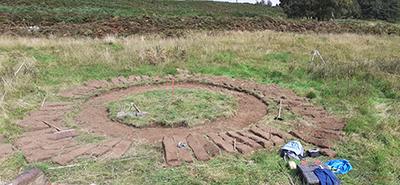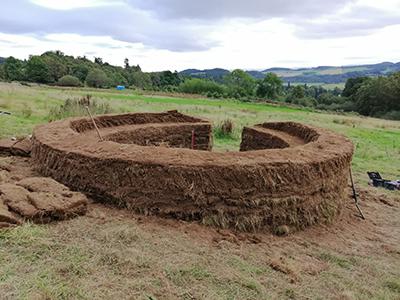Turf - the ancient way to build a better future
A project led by academics from the School - as part of Doors Open Day 2021 - is showcasing ancient building techniques which could offer environmentally friendly alternatives when it comes to building everything from raised beds to garden walls.
We're all encouraged to 'reduce, reuse, recycle' these days, but how can building something with turf help the environment? Dr Tanja Romankiewicz wants people to get their hands dirty as our ancestors once did.
"Building with turf is an ancient technique used to build huge structures like houses and defensive walls, but it's also one which people can use in their own back garden," says Dr Tanja Romankiewicz. "Instead of buying sleepers to build a raised bed to grow your own vegetables, for example, how about cutting turf and building it with that? The cut area will grow back, or you could sow it with plants known to attract bees and other insects, raising the biodiversity of your garden. When the bed begins to decay you can compost it and start again. No waste. And you would be doing what people did in Scotland 3000 years ago up until very recently, using turf in their everyday building."

To demonstrate how turf building works staff of Comrie Croft eco-farm near Crieff and locals interested in natural building have created a circular turf-walled enclosure in the lead up to this year's Doors Open Day on Saturday 18th September. The structure is inspired by evidence of prehistoric roundhouses in Perthshire, based on Dr Tanja Romankiewicz’s research and the construction was led by professional turf builder Daniel Postma. The work is supported by a Knowledge Exchange and Impact grant from the University’s College of Arts, Humanities and Social Sciences - and you can meet Dr Romankiewicz and hear about the turf structure at Comrie Croft on Doors Open Day, this Saturday 18th September. You can also get your hands dirty there and then - and have a try at building in turf like the Romans!

Investigating GRASSROOTS: past, presence, future
Dr Romankiewicz, Chancellor’s Fellow in Archaeology, has been conducting research into turf building which has shown that the technique was part of prehistoric agricultural cycles - from cutting to building, decaying, composting and regrowing. A project grant from the Edinburgh Futures Institute is now supporting her and newly appointed Research Assistant Hannah Genders Boyd in piloting the assessment of this turf building life cycle – from cradle [growth] to grave [composting and regrowth] - and partly exploring the potential for increasing biodiversity, carbon capture, and Natural Capital by building with turf in a modern context. The project - GRASSROOTS - aims to prepare the ground for further large-scale research and to enable local communities to use turf for their own sustainable building projects.
Turf was not only used in prehistory, but also by the Roman army for their fort ramparts and of course for the Antonine Wall. To demonstrate how the Romans built with turf, Dr Romankiewicz has teamed up with Dr Russell to build a scaled replica of a Roman fort wall on Doors Open Day, this Saturday 18 September at Comrie Croft. Everybody is welcome to join this building activity, inspired by the evidence from Vindolanda and nearby Strageath. This work is based on Drs Russell and Romankiewicz's research as part of the Leverhulme Trust funded Earthen Empire project.
Cycle Roman Crieff
To push the sustainability aspects of Dr Romankiewicz’s GRASSROOTS work, and tying in with other local Doors Open Day activities, Crieff and Strathearn Museum have commissioned a cycle map of Roman Strathearn, kindly supported by the Gannochy Trust. Hannah Genders Boyd has put together this map to guide visitors around key Roman sites in this ancient landscape in an eco-friendly way. Access the map - called Cycle Roman Crieff - at the link below or on the Crieff and Strathearn Museum website beyond the Open Day activities.
Doors Open Day at Comrie Croft
View the Cycle Roman Crieff map
Further information
Dr Tanja Romankiewicz's staff profile Dr Ben Russell's staff profile Daniel Postma (Archaeobuild)

